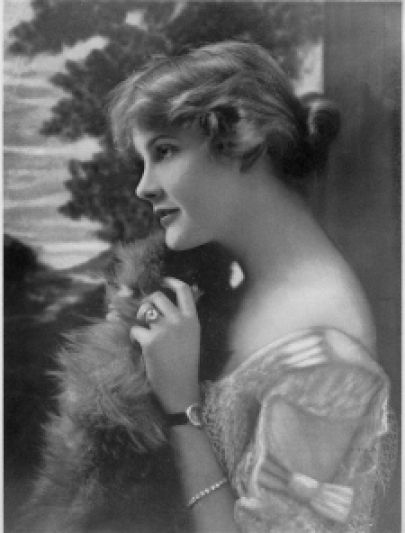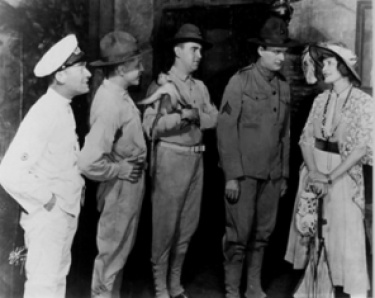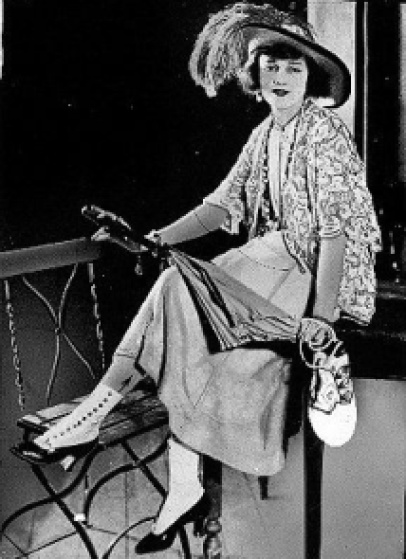Why the stage’s most recognized Sadie Thompson didn’t appear in the film
(Classic Movie History Blogathon)
In 1922, a play opened in Philadelphia that underwhelmed the population so much that it closed within weeks. Producer and promoter Sam H. Harris, his client Jeanne Eagels, and the rest of the cast and crew had to decide whether they would fold it up and lick their wounds or try another tack with it. Rain was not the success they had hoped it would be. Jeanne vociferously defended Sadie Thompson, the main character, whom she’d fallen in love with. She refused to let the show die. So with a little reworking, they reopened at the Maxine Elliott Theatre in Manhattan. And American theater has never been the same since.
A young and beautiful Jeanne Eagels.
Who was Sadie Thompson? And who was Jeanne Eagels?
Sadie Thompson was a woman of dubious morals, on the run from illegal activities in San Francisco. She happens to be on a ship that docks in Pago Pago, Samoa in the South Seas. Also included in this equation are Trader Horn, who manages the general store with his native wife, a battalion of Marines headed for Subic Bay in the Philippines, and a holier-than-thou priest and his wife (the Reverend and Mrs. Davidson).
Jeanne as Sadie with the Marines
“I don’t want to be a prostitute,” Jeanne told Sam Harris. “The play doesn’t call me one. I can’t feel myself a prostitute. I don’t want to be cheap, sordid and vulgar.” When Harris told her that she wasn’t a prostitute– that she was a common streetwalker, he told her that she had no morals, but no malice either. “All right, I’ll be a common harlot then, but not a cheap one.” What she did do was to make the part her own. She shopped carefully for the look she wanted, scouring New York shops for the perfect type of dress and hat and shoes. According to biographer Edward Doherty, “she found the shoes at a dingy East Side bargain counter, after weeks of searching for them. She paid $2.00. They were on sale.” Supposedly. she ordered a dozen more pairs just like them. The famous hat with the sad droopy plume she found at a shop in the Bronx. And a secondhand store in The Bowery was the source for her white lace coat with peach sateen lining. She found the bedraggled parasol at a fire sale, and the multitude of bangles from a five and ten cent store. From her first sashay onstage, she took over the character, getting inside her head and exploring her personality and motivations. “Sadie wouldn’t do that,” she was known to say. And she defended her fiercely.
When someone once asked her if she’d like to visit the Barbary Coast, “where Sadie was from,” Jeanne lost it. “How do YOU know she was ever there?” she said crossly. Nothing in the play indicated it. She wanted to get the most out of life, that was all. “Does anybody actually KNOW Sadie is a harlot?” No one could tell her. Two years after her lover, Thomas Chadbourne, deserted her and married Mrs. Chadbourne, the couple attended the opening night of Rain. According to Doherty, she ignored Chadbourne until the second act, where she turned all her vitriol at Reverend Davidson. But she was not speaking to Davidson, she was accusing Chadbourne. That last word of her tantrum, “sonofabitch,” was covered in fury.
Her persona became ingrained in the American consciousness. In All About Eve, George Sanders mentioned Jeanne as one of the greats he’d worked with, over twenty years after her death.
So, in 1927 when Hollywood inevitably decided to film its own version of Rain, Jeanne would have been the obvious choice for the part. Why then, was Gloria Swanson selected instead?
In a word:
Clout.
Gloria Swanson was one of the biggest female stars at the time, all due to her work with director Cecil B. DeMille on pictures like Male and Female, The Affairs of Anatole, and Why Change Your Wife. She had recently married an impoverished French nobleman named Henri de la Falaise de la Coudray. She was a marquise.
Obstacle #1 – Rain was on the Motion Picture Production Code’s list of theatrical works that could not be filmed, due to Sadie’s line of work.
However, cagey Gloria Swanson worked with some writers to finagle important details (Sadie’s profession became fuzzier, and the reverend became a reformer). And most importantly, they changed the movie’s name to Sadie Thompson so that it wasn’t associated with the scandalous Broadway play of the same name. Because of her wealth and pull in Hollywood, Swanson pulled a fast one on the censors.
Obstacle #2 – Jeanne’s dislike of films.
At the time, the gulf between theater people and “movies” was much wider. Although stage plays did provide fodder for the newer medium, for years theater people had looked down on film people as upstarts. No one wanted to actually admit they made flickers. Until the money began rolling in, and in, and in… and then the talkies arrived. Directors needed trained stage voices. That was when things really changed.
Jeanne had done her time in films in the early part of her career, working for the independent Thanhouser, which was based in New Rochelle, New York. During 1916 and 1917, she made several films, including The World and the Woman, The Fires of Youth, and Under False Colors.
She loved California– loved the sun and the warmth and the people. It was the industry she couldn’t stand. As Doherty says, “Movies, she believed, were made by stupid people, of stupid people, and for stupid people.” And she didn’t feel like films had progressed much past where they’d been a decade earlier when she’d been in them to pay the bills.
When Rain‘s run was complete, Jeanne and her husband, Ted Coy, had traveled to California, and the next thing anyone knew, she was making Man, Woman, and Sin with John Gilbert. She’d been convinced to join by Monta Bell, the director, but supposedly she hated everyone on the lot. Except Bell and Gilbert.
Jeanne and John Gilbert, with whom it was rumored she had an affair
It was the routine she hated– having to get there so early, getting made up, and then waiting around– sometimes for hours, sometimes for days– for technical issues to get ironed out. The lights, the cameras, the director, the editing…she had no patience for it. Finally, she walked off set. For three days.
Obstacle #3 – Jeanne herself.
The furor over her behavior on the Man, Woman and Sin set AND during the play, Her Cardboard Lover, cemented Jeanne’s reputation as difficult and unstable. Erratic behavior, missed performances, and rumors of drunken binges followed the show. Due to the fallout, Jeanne was fined two weeks’ pay and banned from the live stage for eighteen months by Actors Equity. She was casual about the whole affair, and did a stint on vaudeville in the meantime. She knew it would pay more than legitimate theater, and movies would pay even more than that.
But her descent had begun. Alcoholism slowly and surely began to claim her. Rumors of drug abuse surfaced after her death as her behavior became more and more unstable. Supposedly, she had a broken heart when Swanson played Sadie, but Swanson had done the legwork to earn the part for herself. And Jeanne couldn’t be bothered to work in Hollywood voluntarily. Plus, in addition to the alcohol, she had a myriad of health problems with sinuses etc that inhibited her work at times.
Jeanne as the murderous Leslie Crosbie in The Letter
Only after her suspension did Jeanne find Hollywood a legitimate enough source of income to complete the two films we know her for today. The first was the brilliant W. Somerset Maugham work The Letter, where she played the murderous adultress Leslie Crosbie, and the second was Jealousy. Since both are talkies, we can fully get a sense of her acting skill and ability to fully inhabit a character.
It’s a true loss that we never got to enjoy Jeanne on film playing the role she was known for, but Swanson comported herself admirably in the role. If only Jeanne had had the foresight to ensure that her Rain legacy included film as well as live theater.
Conclusion: Jeanne Eagels was robbed!
This has been my entry in the Classic Movie History Blogathon, hosted by Silver Screenings. Check out these other great entries! A wealth of amazing film history lore. Check it out, y’all! I’ll be reading for days.
THE SILENT ERA (1880-1929)
1880-1895: Eadweard Muybridge and the Black Maria: The birth of the movies
| Silent-ology | Early History of Film |
| The Movie Rat | The Muybridge Experiment |
1896-1900: From novelty to art: The movies increase in popularity
| Silent Volume | The Best Pre-Feature Movies |
| Christy’s Inkwells | How I Learned to Love Silent Movies |
1901-1907: The first hits: Melies, Edison and the blockbuster
| Big V Riot Squad | Life of an American Director: Edwin S Porter in 1903 |
1908-1913: Nickelodeon! The movies in the mainstream
| 365 Days 365 Classics | India’s Silent Era Movies |
| Silver Screenings | Early Trick Photography The Thieving Hand (1908) |
| Now Voyaging | The early career of Lois Weber |
1914-1918: The War and the feature film: The move away from shorts
| Now Voyaging | Movie audience perceptions of the war |
| Century Film Project | Regeneration (1915) |
| Once Upon a Screen | Birth of Fox Studio – a centennial tribute |
| Yesterday, Tomorrow and Fantasy | Tom Sawyer, the 1917 Film |
| The Cinematic Packrat | A Brief History of MGM |
| Sir Arthur Conan Doy’s Lost World | William Selig’s Lost World |
1919-1923: Hollywood triumphs: Post-war dominance
| A Small Press Life | Anita Loos: Females in Early Hollywood |
| Movies, Silently | Home Theatres of the Silent Era |
| vivandlarry.com | James Abbe: Capturing the silent screen |
1924-1927: The high art of pantomime: The silent film reaches artistic heights
| Sepia Stories | Jeanne Eagels was Robbed. Why the stage’s most recognized Sadie Thompson didn’t appear in the film. |
| In the Good Old Days of Classic Hollywood | John Barrymore in Don Juan & the introduction to Vitaphone |
1928-1929: The last of the silents: The talkie revolution
| film, fashion & frivolity | Garbo’s Last Silents |
| Critica Retro | 1928 Around the World |
| CineMaven’s Essays from the Couch | The Crowd (1928) |
THE GOLDEN AGE (1930-1952)
1930-1931: All Singing! All Dancing! All Talking! The end of the sound transition.
| A Person in the Dark | Early Musicals |
| Classic Reel Girl | Early portrayal of taxi dancers: Ten Cents a Dance (1931) and Two Seconds (1932) |
| Cinephilia | Lubitsch Films: 1930-1943 |
| Silver Screen Modes | How Fashions Sold the Movies: 1930-1940 |
| regularpop | Loretta Young’s career |
1932-1934: Is that a gun in your pocket or are you just happy to see me? The wild world of pre-Code.
| Carole & Co. | Of Carole and Pre-Code |
| Girls Do Film | Barbara Stanwyck’s Pre-Code Bad Girls |
| The Stop Button | Son of Kong |
| Wolffian Classic Movies Digest | Bette Davis, dame of the screen |
| stevielounicks | Dinner at Eight |
| In the Good Old Days of Classic Hollywood | Ethel Barrymore’s transition from stage to screen |
| Second Sight Cinema | Development of newsreels, real life influencing Hollywood and vice versa, and presidential politics and policy in 1932-’33. |
| Outspoken & Freckled | Feminism in the Pre-Code Era |
| CineMaven’s Essays from the Couch | Heat Lightning (1934) |
| stars and letters | Correspondence from Joseph Breen from 1934 and 1935 regarding the Production Code |
1935-1938: Let’s misbeha— I mean, lovely day, isn’t it? The Code enforced and the rise of Technicolor.
| Nitrate Glow | Disney’s Early Features |
| Silver Scenes | 1936-A Grand Year in Film |
| CineMaven’s Essays from the Couch | (Guest Post) The Flame Within |
1939: The Big Year. Selections from the biggest year in classic cinema.
| Movie Movie Blog Blog | The Flying Deuces (Laurel and Hardy) |
| Smitten Kitten Vintage | 1939: The Big Year (Selections from the biggest year in classic cinema) |
| MovieFanFare | The Worst of 1939 |
1940-1945: We’ll murdelize that paper hanger! Wartime Cinema.
| The Vintage Cameo | Wartime Musicals |
| Speakeasy | 1943 at RKO |
| The Motion Pictures | For Me and My Gal |
| Way too damn lazy to write a blog | Christmas in Connecticut |
| Phyllis Loves Classic Movies | What the Stars Did to Help Win the War |
| Shadows and Satin | Barbara Stanwyck in Film Noir |
1946-1949: Homecoming
| B Noir Detour | Wartime Cinema: Gentleman’s Agree’t, Crossfire, A Double Life |
| Queerly Different | The Rise and Fall of the Biblical Epic Part 1 |
| Pure Golden Classics | Gilda (1946) |
| regularpop | Lizabeth Scott’s career |
1950-1952: Realism and the Method: New directions
| Sister Celluloid | Stage Fright: Hitchcock Goes Home |
| Old Hollywood Films | Hollywood Expose Pictures (Sunset Blvd, Bad the Beautiful) |
| Hitchcock’s World | Destination Moon (1950) |
| Caftan Woman | Adult Westerns |
| Criterion Blues | The Collapse of the Studio System Parts 1,2,3 |
SWINGING INTO MODERN TIMES (1953-1975)
1953-1957: Rebels with and without causes: The birth of cool
| Back to Golden Days | Juvenile Deliquency: The Wild One, Blackboard Jungle, Rebel Without a Cause |
| Movies Silently | After the Silents: A Face in the Crowd (1957) |
| Movie Mania Madness | It’s Always Fair Weather – The Musical Gets Cynical |
| Voyages Extraordinaires | Scientific Romances in the Atomic Age |
| Silver Scenes | 3-D Films of the 1950s |
| Culural Civilian | Revisiting It Should Happen to You (1954) in a Reality-TV World |
| Queerly Different | The Rise and Fall of the Biblical Epic Part 2 |
| Let’s Go to the Movies | Love as portrayed in key films released during this time period |
| Totally Filmi | The Apu Trilogy |
| Silver Screenings | 3D Film Shorts |
1958-1962: A little song, a little dance, a lot of people with no pants: Musicals, biblical epics and the shimmy-shimmy shakes.
| A Shroud of Thoughts | British New Wave |
| Cary Grant Won’t Eat You | Single Roommates in the City: The Best of Everything (1959) |
| Queerly Different | The Rise and Fall of the Biblical Epic Part 3 |
| Jim Fanning’s Tulgey Wood | The Widescreen Splendor of Walt Disney’s Sleeping Beauty (1959) |
| Paula’s Cinema Club | Roger Corman (guest post by Jack Deth) |
1963-1967: Mod’s the word: And then things started to swing
| The Last Drive In | The Bold & The Beautiful Strong Women of 1960s Film |
| The Wonderful World of Cinema | 1967: An Important Turning Point in Films |
| Reel and Rock | The Girl-Getters aka The System (1964) |
| That Other Critic | Batman (1966) |
| Classic Becky’s Brain Food | 3 Big Films 1969: Midnight Cowboy, Sterile Cuckoo, They Shoot Horses Don’t They? |
| No Nonsense with Nuwan Sen | 1966: The Year dubbed as Nineteen Sexty Sex |
| The Joy & Agony of Movies | Movies: 1963-67 (Topic TBA) |
1968-1972: Hays is dead: The end of the Code
| Portraits by Jenni | Airport (1970) |
| The Joy and Agony of Movies | Films about politics and civil unrest |
| Girls Do Film | The American Road Movie (Bonnie and Clyde, Easy Rider, Badlands) |
| Moon in Gemini | Paranoia in Movies |
| Le Mot du Cinephiliaque | The year 1968 in France’s Cinema |
1972-1975: The Godfather and Jaws: Auteur films and the modern blockbuster
| Once Upon a Screen | Mel Brooks’ Take on Classic Movie Genres |
| Crimson Kimono | The Surveillance Sleuth of “The Conversation” |
| The Joy & Agony of Movies | Movies: 1972-75 (Topic TBA) |








You must be logged in to post a comment.